Planeswalker's Guide to Gatecrash: Part 2

The Simic Combine is Ravnica's steward of nature and the wild; its mission is to preserve the natural world even as Ravnica's cities continue to grow. The guild seeks to protect the elements of the plane that are incompatible or mutually exclusive with its overpopulated, urban conditions. This is not easy, of course, because the forces of civilization are so prevalent on Ravnica that they threaten to subsume anything that runs counter to them. But the Simic practice a strange combination of detachment and holism that provide a kind of separation from the larger urban systems—a separation on which their conservation mission depends.
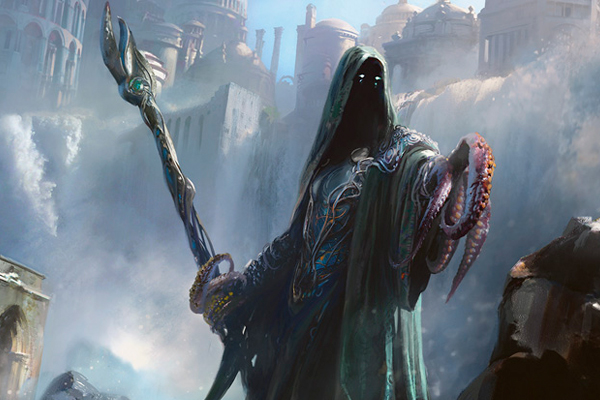
Art by Maciej Kuciara
Simic Guild Structure
Zonots. A zonot is a huge sinkhole that leads all the way down to the Ravnican oceans, and each serves as a distinct Simic habitat—sort of an oversized, inverted skyscraper. Each zonot has a different culture, ecosystem, and racial distribution, as well as a speaker.
- Zonot One. The first to open, Zonot One appeared in a remote area far away from the Tenth District. This is Speaker Zegana's home zonot, although she spends most of her time in Zonot Seven, where the Simic main guildhall is located. Zonot One is the smallest zonot and has a somewhat somber feeling compared to others.
- Zonot Four. The largest of the zonots has the marine troll Trifon as its speaker. The culture here is more brutal and direct than elsewhere, and the residents are larger on average, too.
- Zonot Five. The Simic tend to be insular, but this zonot has become a tourist destination—a place where the guildless can come to see the ocean as well as to observe Simic life. Rather than discourage this, the Simic created the Helical Stair here to draw more visitors.
- Zonot Seven. The only zonot inside the boundaries of the Tenth District, Zonot Seven is home to the guildhall, the Zameck. As one would expect, this is the busiest and most densely populated zonot.
Clades. Simic guild members are organized by clade rather than by species, role, or caste. Each clade is the natural-world equivalent of a project team: diverse individuals adapted to different tasks, yet related by a common goal. Clades often exist solely within a single zonot, but they need not do so, and large clades span two or more Simic communities. Some of the clades include:
- Hull Clade. This clade's focus is on protection, defense, durability, and the like. Its projects range from the strengthening of exoskeletons to the stabilization of zonot walls.
- Fin Clade. The study of movement is this clade's focus—both literal movement of creatures (especially flying creatures) as well as, for example, movement of resources through systems.
- Crypsis Clade. This secretive clade develops strategies for obscuring other guilds' views of the Simic. This includes literal camouflage as well as magic designed to hide knowledge or operations.
- Gyre Clade. Cyclical patterns and metamagic are this clade's specialization. Projects include finding ways to redirect or nullify magic and advancing nature.

Art by Chase Stone
The Holdfast Principle. A holdfast is a biological structure that kelp and sponges grow on to anchor themselves to rocks or other objects on the sea floor too heavy for currents to move. In the Simic context, this structure has inspired a philosophical dogma that advises guild members never to stray so far from nature that they become "adrift"—a veiled warning against the excesses and ambitions of the guild's previous iteration. The Simic guild rank and file tends to stay close to their zonots for this reason, and Simic forays into city life are generally shorter than those of other guilds. The zonots themselves are sort of huge columns of sea grass or kelp in negative space, and the ocean far below is the object to which they are "anchored."
The Upwelling. The Holdfast Principle doesn't mean the Simic are isolated or xenophobic, however. The opposing idea, stronger in Simic culture, is that of the Upwelling. In science, upwelling is an oceanographic phenomenon in which nutrient-rich water moves toward the surface, replacing depleted water. For the Simic, this is a spiritual concept that bridges disciplines and pursuits. The return of the deep creatures to the surface, the birth of ever-larger organisms, the pursuit of natural science and understandings, the slow addition of new zonots... all are upwellings. The new and enlivened replace the old and depleted, and that replacement is cyclical.
Speaker Zegana. The regal and reticent merfolk woman named Zegana is the current guildmaster of the Simic Combine. She is the speaker for Zonot One, the first to emerge on Ravnica, and she delivered the Fathom Edict that declared a new beginning for the Combine. Zegana is quick to point out, however, that she speaks at the discretion of the Speakers' Chamber, a secretive body of all nine of the zonots' speakers. She claims that the Chamber can revoke that status, at which time another speaker would replace her as the guildmaster. Many outside the Simic believe this is false modesty, however, and that Zegana controls the Chamber—if it meets at all.

Art by Willian Murrai
Zameck. The Simic guildhall is not a particularly ceremonial or celebratory place. In Zonot Seven, a huge chamber just below the surface has been cleared of debris and serves as the gathering place for all the speakers, as well as a place where non-Simic visitors can meet with Zegana or other Combine emissaries. The roof contains many openings to the sky covered over with plax to create opalescent skylights, which makes the chamber seem almost as though it's underwater. Thick cords of kelp buttress the walls of the huge chamber, and algae cakes the corners and edges of walls and floors. But the main chamber floor is clear, with the exception of a large table in the shape of a loose spiral, with a slightly elevated podium at its center.
The Helical Stair. At Zonot Five, an enormous column of marine plant matter has been coaxed by magic to grow steadily up the walls of the zonot in a gentle spiral. Stairs have been carved in the spiral (and de-slimed), forming a long path by which surface dwellers can walk down to sea level. This is a Simic outreach to the people of Ravnica—a place where its denizens can see, touch, step into, and even swim through the cold oceans they forgot millennia ago.
Jezeru, the Lake District. In recent years, the sentient among the Simic have collectively realized that they risk over-isolation in their zonots. In an effort to increase relevance and visibility, the Simic have made conscious efforts to bring their guild aboveground. The most dramatic example of these efforts is Jezeru, an entire district that now lies underwater. The water is only several feet deep in most of this shallow, natural valley area, although at its deepest it reaches forty feet or so. Terrestrial creatures can navigate the district via flying Simic "ferry" creatures as well as by stone walkways kept afloat by oversized pneumatocyst growths.

Art by Wesley Burt
Krasis. Any Simic hybridized lifeform is called a krasis, the catch-all term for such creatures. The new Simic Combine is careful not to repeat the mistakes of Vig and his bioengineers, but the guild still uses magic to coax new morphologies from existing creatures, as well as to combine traits from multiple organisms in one. Some of these are unique creatures that can't reproduce. A few multiply and become part of the guild's fabric.
Simic Attitudes Toward Other Guilds
- Azorius: "The Senate is well intentioned and far-sighted. But its insistence on caution and control paralyzes it. This is unfortunate, because the surface world needs its leadership, even if we do not."
- Orzhov: "No other guild poses so great a threat to us and our mission. The Orzhov replace intellect with obedience and strength with money. They are the greatest enemies of nature and Ravnica's people."
- Dimir: "Such a disappointing waste of knowledge and insight. They do nothing but transform information into a currency with which to buy power and privilege. In time, life will conquer their deathly, shallow machinations."
- Izzet: "Their efforts are to be admired and learned from, but their disregard for natural systems reveals the short-sightedness of their thinking. Life will in time devise smarter solutions than the Izzet could ever concoct."
- Rakdos: "We must strive not to understand them, but to understand why they are allowed to persist—what needs they fulfill for the citizenry. In the meantime, treat them as rabid animals. Keep your distance."
- Golgari: "If they desired allies, we would be their closest. But they focus too much on the viciousness of natural cycles, even turning against their own. They have no patience for anything that doesn't yield power."
- Gruul: "Their base desires keep them at the fringes. Our patient, measured adaptation will prevent us from suffering the same fate. When they come to us for aid, we will not turn them away."
- Boros: "A dangerous combination of emotion and organization. Whether acting of their own accord or under the influence of an external force, the Legion turns its fears and desires into effective aggression."
- Selesnya: "The Conclave understands holism but impedes progress with a layer of mysticism. We admire their collectivism but not their dogmatism. We strive to retain specialization rather than suppressing it."
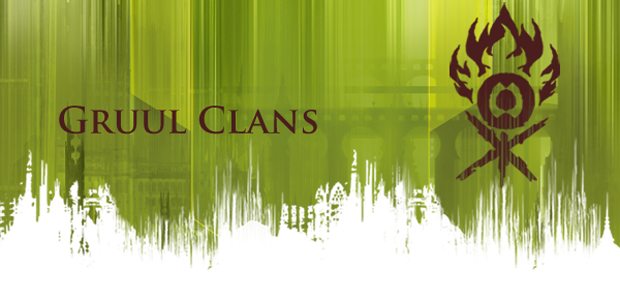
The Gruul are a loose affiliation of savage clans that squat in Ravnica's alleyways, abandoned zones, and ruins. Many of the Gruul clans have come to occupy the Rubblebelt, a broken thread of war-ruined land and settlements that begins near the outskirts of Ravnica's Tenth District. Warfare among the Gruul is constant and almost ritualistic; the Gruul believe that only the strong should survive and rule. The Gruul are the most disenfranchised and hold the most anti-civilization views of all of Ravnica's guilds, and as such are the most ill at ease in a world covered by city.
Borborygmos, the Clan Alpha. Although no Gruul clan leader has ever managed to dominate or unify all the clans, one Gruul clan leader is spoken of in reverential tones: Borborygmos. An unusually massive cyclops and the savage leader of the Burning Tree clan, Borborygmos "smashes his enemies into paste, then uses that paste to polish his boots," as the saying goes. Borborygmos has defended his position as the Gruul's mightiest clan leader for several decades now and has killed many upstarts. But although he's still an extraordinary warrior, Borborygmos is beginning to show his age. The challenges to his leadership have become more frequent and his victories more narrow.
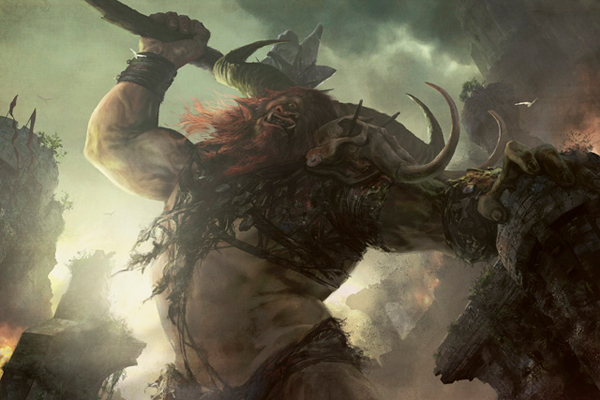
Art by Aleksi Briclot
The Gruul Clans. New clans occasionally form under ambitious Gruul warlords, and meanwhile other clans are occasionally challenged, defeated, and wiped out. These six, though, have existed stably for some time.
- The Burning Tree clan, led by Borborygmos, is the most fearsome and powerful. This clan is also the largest and most diverse, having branches in several districts of Ravnica. The fear and awe inspired by Borborygmos himself allows this clan to keep a strong reign over diverse and geographically separated members. The symbol of the Burning Tree clan has come to be regarded by the Ravnican populace as the symbol for the entire Gruul guild.
- The leader of the Ghor clan, Ruric Thar, is a two-headed ogre who rules his clan with barbaric cruelty. He also claims to be the only Gruul warrior to face Borborygmos himself and live, although one of his heads is hideously deformed as a result of the battle. Of all the clans, the Ghor execute the most frequent and savage assaults on Ravnican citizenry. The clan typically creates encampments close to heavily populated Ravnican districts. Ruric Thar likes to terrify the "cobble roaches," as he calls them, with the boisterous, blood-gurgling sounds of his clan's chaotic assaults.
- The Scab clan is made up of a variety of races, including minotaurs, centaurs, ogres, and goblins. They are easily distinguished by their beastly looking scars and body mutilations. Scab clan warriors despise pretentiousness and false airs. They believe that the body is the outward form of the spirit, and that the more maimed the appearance, the more authentic the warrior. The Scab have engulfed or destroyed several clans in recent years, but the leader of the clan, a corpulent giant known as Narbulg Nine Fingers, has not yet deigned to challenge Borborygmos or the Burning Tree.
- The Bolrac clan is made up of large lumbering brutes, primarily cyclopes, ogres, trolls, and giants. The clan's leadership changes almost daily, since brutal battles for supremacy are as common as meals. The word "bolrac" is an old Ravnican word meaning "heavy hammers," and the Bolrac specialize in bringing down massive structures using mauls and battering rams. The only thing the Bolrac love more than destroying something smaller than them is toppling, crumbling, and then destroying something that was once larger.
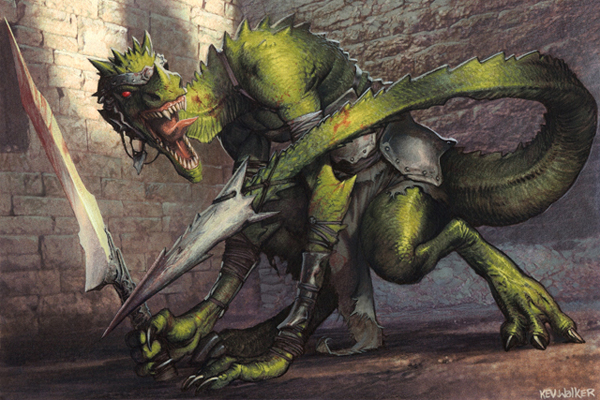
Art by Kev Walker
- The Slizt clan is a clutch of sly, stealthy, mostly viashino warriors, although they have been known to accept the odd "pinkskin" (human). This clan has survived in the Rubblebelt by using three tactics: stealth, high ground, and ranged attacks. The Slizt settle in the highest portions of ruins and ambush foes with a flurry of arrows from above. Other Gruul clans regard the Slizt as skulkers and cowards, but all are cautious when entering areas with elevated ruins. The home ground of the Slizt clan is The Husk, an area at the center of the Rubblebelt that has many large and ancient structures that have somehow remained standing for many generations.
- The Zhur-Taa clan, also known as the "skull bleachers," is the only Gruul clan that claims to follow "the old ways." The Zhur-Taa are very close to their beasts; their shamans are adept at summoning and training beasts for war-companions and mounts. The Zhur-Taa worship the Utmungr, "gods of the deep earth," and await the awakening of an ancient boar god who will mount a fiery rampage and raze the over-civilized world once and for all. The Zhur-Taa stack large piles of skulls, humanoid and animal alike, as offerings to these believed gods. Their Zhur-Taa leader, Nikya of the Old Ways, is a powerful shaman who, it is said, can summon massive vines from the ancient layers of Ravnica's crust.
Skarrg: the reunion turf. In the gutted, cratered remains of a massive palace, a great bonfire burns, marking a place of tradition for the Gruul. Skarrg is not exactly neutral ground for the Gruul clans, as no truce is called and old grudges tend to lead quickly to bloody combat. But Gruul clans periodically converge on Skarrg from every corner of Ravnica. Giant boars are roasted and great battles are fought, and here the Gruul find something akin to camaraderie.
The Rubblebelt. Every district has its share of Gruul squatters and street toughs. But many Gruul guild members inhabit a discontinuous archipelago of wasteland zones outside of the Tenth District. The Rubblebelt is a mass of gutted buildings; transitory shantytowns; and strange, roaming, ruin elementals. "The Belt" is surrounded on all sides by more civilized areas; other guilds often attempt to encroach on this area and try to reclaim it for their own uses, generating endless conflict with the civilization-spurning Gruul.
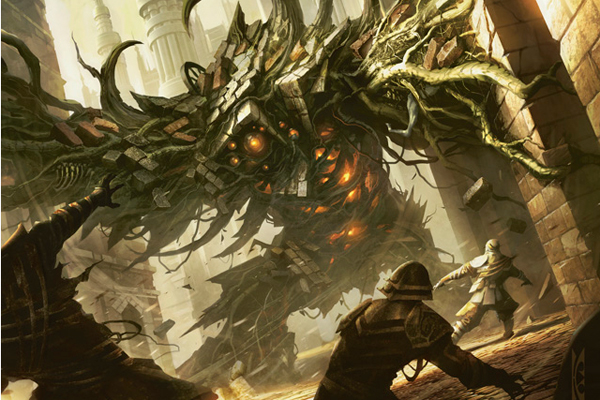
Art by Raymond Swanland
The Old Ways. In the time before the guilds of Ravnica were formed, the Gruul were a collection of druids and shamans who celebrated and claimed the wilds of the plane. Obviously, the Gruul failed at this task. Some sages surmise that it was the moment when a Gruul shaman saw the last towering druid-tree fall, and the last sacred grove was dug out for a stone quarry, that the spark of outrage was kindled. That spark became an all-consuming need to take vengeance on civilization and those who worked for "progress."
In this current age, most Gruul clans simply live by the rule that "the strong survive, the strongest rule," but there is still a small spark of the old ways left in certain Gruul clans. The Zhur-Taa believe that the quakes that rumble across the Rubblebelt are a sign that the gods of the deep earth are awakening and preparing to rise up and destroy the "cobble roaches." The Zhur-Taa believe that the first sign of this apocalypse will be the coming of Ilharg, the boar-god.
Rauck-Chauv: anarch's "holiday." The Gruul observe few consistent traditions but love to celebrate Rauck-Chauv, an irregular, calendar-mocking festival characterized by several days of rioting, feasting, looting, and destruction. Scholars note that Rauck-Chauv honors the principles of the Gruul's anti-intellectualism, having its roots in an ancient druidic promise to root out the artifice that underpins the unnatural institutions of city life, but the Gruul just revel in the excuse to smash things.

Art by David Palumbo
Gruul Attitudes Toward Other Guilds
- Azorius: "Our world is diseased and the Azorius are the plaguebearers. Once they are destroyed, Ravnica will regain its primal essence."
- Orzhov: "A guild of ghosts and liars. Best not to have pockets for them to pick."
- Dimir: "Weaklings clad in menacing shadow. Hold the Dimir up to the light and you'll see them for the pale, scrawny wretches they truly are."
- Izzet: "While the Izzet fiddle with their theories and cower at the feet of a dragon, the strong carve up the world."
- Rakdos: "The Rakdos know fear is power. They hold no power over the Gruul."
- Golgari: "The Golgari know that to tear down this city, you start at the foundation. But their hearts have been deceived by whispers of power."
- Boros: "We respect the Boros! So their heads adorn our pikes instead of plugging the gutters."
- Selesnya: "A Selesnyan would coddle a wolf, teach it to fetch sticks, and call it a dog. We prefer to starve the wolf, let it hunt for its food, and make a stronger wolf."
- Simic: "The Simic enjoy twisting nature, but they will not enjoy it when nature twists back."

The Orzhov guild was founded on the belief that wealth is power, that structure breeds wealth, and that guilt creates structure. The guild is run like a combination religion, credit-lending agency, and crime syndicate, with an ostentatious hierarchy of priests, enforcers, and ghostly councilors ruling over a congregation of guiltbound servants, indebted ghosts, and thrulls. Many Orzhov guild members truly believe that their rule is necessary for making Ravnica the best it can be, and they are unscrupulous in their methods of making sure they seize power. Most Ravnicans see the Orzhov for the corrupt organization they are, but many are lured in by their promises of wealth, prestige, and longevity.
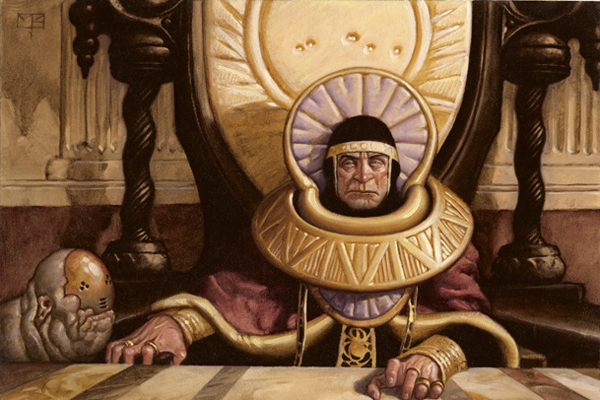
Art by Mark Zug
The Obzedat, the Ghost Council. The Orzhov guild is ruled by the Obzedat, a council of ghostly autocrats who have maintained their wealth and power even as they've shed their mortal forms. Members of the Obzedat are called the Deathless, as they have managed to cheat mortality, maintaining their consciousness (and their greed) beyond the threshold of death. Most of the Deathless appear as morbidly obese high priests or nobles, but sickly, pale, and ghostly in form. They are as paranoid and spiteful as dictators, often going out of their way to thwart ambitious underlings, crush rumormongers, and spy on potential enemies. They crave wealth, respect, and loyalty. The Obzedat rarely speak directly with those outside the guild; instead, they communicate through the official Grand Envoy, Teysa Karlov.
The Cartels. Reporting to the Obzedat is a web of cartels, which are the individually operating units of the Orzhov Syndicate. Each cartel claims different territories and markets across Ravnica, and each has its own internal hierarchy of priests, lawmages, enforcers, and others. Each cartel is ruled by a cardinal or kingpin whose role is somewhere between gang leader, bank manager, and high priest. Cartels quarrel among themselves over resources and markets and how best to curry favor with Teysa and the Obzedat.
Teysa, Grand Envoy of the Obzedat. The greedy, patriarchal ghosts of the Obzedat and the bickering leaders of the various cartels tend to be poor spokespeople for the Orzhov Syndicate. The human Teysa Karlov has taken a special, unprecedented position called "Grand Envoy," serving as the official speaker and ambassador for the members of the Obzedat ghost council. Once an advokist and lawmage who was instrumental in forging the current wording of the Guildpact, Teysa is now of middle age, her youthful resourcefulness streaked with wisdom and perspective. She has grown into her ambition well; her unique position allows her not only to express the will of the Deathless, but also to mold policy for her guild. Teysa is not the official ruler of the guild—the Obzedat still holds that position—but many believe that to cross Teysa is to cross the entire Syndicate.
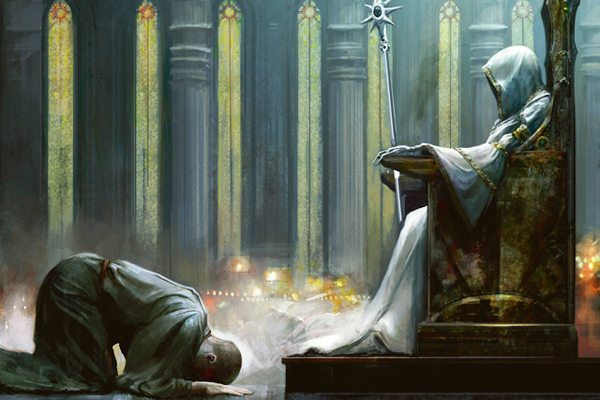
Art by Seb McKinnon
Orzhova, the Cathedral Opulent. The guildhall of the Orzhov is Orzhova, sometimes called the Church of Deals. It's a lavish cathedral with soaring ceilings, designed to make anyone who enters it feel insignificant and out-of-scale by comparison. Overblown stained glass windows and oversized marble statues depict an array of wealthy bishops, enforcer angels, and ghosts.
Irbitov: the mausoleum district. When an Orzhov magnate is laid to rest, he or she is often entombed at Irbitov, an Orzhov-controlled quarter populated with mausoleums, memorial statues, and underground vaults. Irbitov is patrolled by thrulls, priests, and the occasional practitioner of necromancy. The carvings on headstones in Irbitov are said to change, accurately reflecting the financial status of the deceased.
Vizkopa Bank. The center of Orzhov commerce is Vizkopa Bank, a massive institution encrusted with guardian gargoyles and orbited by the floating spirits of Orzhovan debtors. Vizkopa is not only where the guild keeps the majority of its wealth, but also where most Ravnican money is minted. The core of Vizkopa is protected by a mighty, faceless specter whose voice is said to curse the soul.
Coiner's Row. Several Ravnican neighborhoods are dominated by ostentatious Orzhov churches, but one street contains more Orzhov priests and syndics (administrators) than any other district. Coiner's Row is named in part for an ancient forge on this street where coins were once minted (a function now served by Vizkopa Bank). But now the name has a new meaning, referring to the grandiose displays of coin jewelry and wealth of the Orzhov guild members who conduct business here. Coiner's Row supports many high-end shops and restaurants, and those who do not meet its high standard of decorum are not welcome.

Art by Ryan Barger
Orzhov Roles
Clerics: practitioners of the hollow religion. Many of the middle tiers of the Orzhov hold some sort of official religious rank in the guild, from lowly ministrants to high-ranking pontiffs. Orzhov clerics may seem faithless compared to religious practitioners of other planes; they follow their beliefs, but their beliefs center around the distribution of power rather than a divine figure. Clerics are named by their duty. Sinstrikers castigate those who don't follow Orzhov doctrine. Absolvers release followers from their sin, usually in exchange for some lavish gift or favor.
Enders: professional life-takers. Being a killer for the Orzhov can be a complex duty and can come with many labels. Some are executioners—giants who carry out the righteous judgments of the pontiffs. Some are spectral assassins who "sever business relationships" with snitches and other untrustworthy partners. Others are honorable soldiers who protect the public by eliminating threats. Should the Orzhov decide to end someone—either an Orzhovan or someone outside the guild—the Orzhov like to use the termination to send a message to others. Orzhov killings are often signed with some sort of calling card, or even advertised proudly with a complicated ceremony.
Knights: paragons of virtue and vice. Knighthood is an honorable status bestowed on Orzhov members who have proven their loyalty and skill in some way. Each time a person is knighted, he or she is becomes associated with a title that expresses some quality of character. This quality need not be a traditionally positive virtue. For example, a Knight of Penance might be a knight who stands for the virtue of atoning for one's past mistakes, while a Knight of Despair might be one who brings woe to the enemies of the Syndicate.
Syndics: maintainers of the fine print. The Orzhov employ a small army of attorneys, advisors, directors, accountants, counselors, and couriers who manage the business and administrative activities of the guild. Generally, these guild members are called syndics, although they bear a variety of names. Some are powerful lawmages, sometimes called advokists, who are capable of enforcing contracts and creating "verity circles" to encourage associates to speak the truth. Some are coiners, who lend money and keep accounting of the debts of various Ravnican citizens. Some syndics are traffic merchants who coordinate the flow of resources (legitimate and otherwise) and schedule transactions with outside parties. Others, such as fences, hide stashes or carry goods through checkpoints. Although they are not as ostentatious as pontiffs or members of the Obzedat, syndics wield substantial power in the guild, as they often control how the guild interfaces with powerful forces beyond its own membership.
Thrulls: Constructed from flesh, with mask-like faceplates made from devalued coinage, thrulls occupy the bottom rung of the Orzhov status hierarchy. They are magically created to work as servants; they can be found waiting on their masters, fetching messages, or guarding basilica entrances. Skilled death-priests and thrull-fashioners can create larger thrulls outfitted for even stranger purposes—as flying mounts, palanquin-hauler beasts, or walking armored vaults. Some of the Orzhov elite treat thrulls as fashion accessories, parading them around on chains of linked coins like pampered pets.
Angels: unfettered powers. Angels are rare among the Orzhov. Angels are traditionally manifestations of faith and community, and so most angels are loath to associate with the guild of wealth and greed. But occasionally an angel becomes disillusioned by the simplistic principles and military strictures of the Boros and desires a place where she can find proper respect. An angel who can aspire to be only a foot soldier among the Boros has the chance to wield the power of an icon among the Orzhov. Orzhov angels can act as executioners, commanders, pontiffs, or other high-ranking officials, but more often they tend to forge their own job descriptions. Angels fly by their own personal codes of order and execute them efficiently and mercilessly.
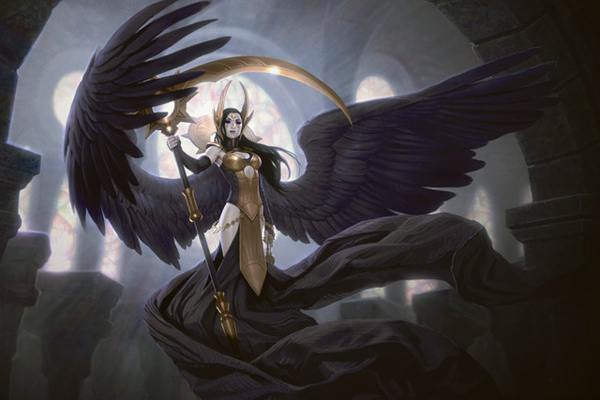
Art by Jason Chan
Spirits: undead debtors. When an Orzhov guild member dies, his or her debt to the guild is usually not paid. Servitude that persists into undeath is often a condition of membership, allowing the Orzhov to command hundreds of spirit servants at any one time. Note that these spirit-debtors are in a much different plight than the ghost councilors of the Obzedat, who have achieved a state of deathless, autocratic power.
Orzhov Attitudes Toward Other Guilds
- Azorius: "They worship process more than purpose. But we admire their devotion to strict order; it is the first brick in building an empire."
- Dimir: "The Dimir are our mirror in some ways, and therefore a threat to all we attempt to create. We must see them join our hierarchy or see them destroyed."
- Izzet: "Excited children who have lost their way. They could be useful pawns if they got a lesson in loyalty."
- Rakdos: "A danger to themselves and others. A threat to longevity and wealth. They must be controlled."
- Golgari: "Death is not the end; on this we agree. But bugs and fungus do not an empire make. They are like us without hygiene, wealth, or self-respect."
- Gruul: "The Gruul are a cautionary tale. They are what become of every culture without strong leadership."
- Boros: "The Boros are limited in their vision but useful in their willingness to execute. Their passions are the strings by which they may be played."
- Selesnya: "They share our vision for a unified world, but their dryads would sacrifice valuable institutions at the false altar of nature."
- Simic: "Their roots reach deep into history. But if their interest stops at extending life, they're missing at least half the story."
